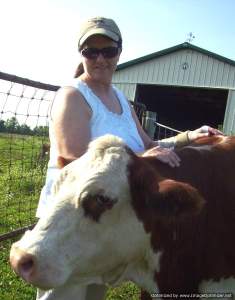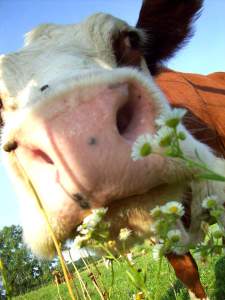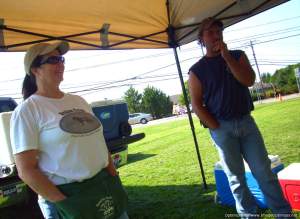Janet Graham and Graham Beef Cattle
If I were to mention the word “beef,” I would generally expect most to imagine a juicy porterhouse steak fired over a charcoal grill and served with a cold beer. I’m not surprised if you are salivating right now. However, how often does the consumer link “beef” with the cow in the field? How many times has the average consumer even seen a beef cow, let alone meet the cow that he or she intends to eat? Generally, the number is incredibly small. In most cases, the beef we typically consume is raised out-of-state, processed in another state, and shipped to your local food market via semi-truck. The supply chain is largely stretched out to improve efficiency and lower prices; however, an efficient supply chain also limits the consumers’ awareness of the cow’s origin, as well as the treatment of the meat before and after slaughter.
However, there are alternatives to “mystery meat,” and one option is located on Morgan Road. Janet Graham, the sole owner and operator of Graham Farms, is the steward of forty three free-range, grass-fed Herefords. Unlike the corporate/industrialized operations that externalize the health of the cow for increased profit margin, Janet profits from the health of her cows. Instead of corn (which causes ulcers, hence the antibiotics), Janet allows her herd to peruse grass laden pastures to satisfy their palate. Instead of confined stalls, Janet’s herd is free to enjoy a sixty acre expanse, consisting of meadows and forests. Essentially, the Herefords at Graham farms have the freedom to follow their instincts.
“Everything I do is based on the free-range philosophy, which is grass all summer and grassy hay for the winter,” Janet explained. “We have always done the free range since they are Herefords, and Herefords can handle the weather. I believe, as many people believe…that it is healthier — the meat is better, and it’s a lot healthier. The public is becoming more aware now.”
However, there are few people who suddenly aspire to become the host to a herd of 1,200 pound Herefords. Such a practice is rooted in conviction, usually values conceived individually, or from past generations. For Janet, it was both.
“I grew up on a farm in Chili Center…helping my father. Then, when I was about twenty, I went and started working. I finally settled at RIT, earned my bachelors and masters degree, and actually worked there for twenty-four years. In the meantime, I still helped my father. I didn’t do it twenty-four-seven, but whenever I could, I was helping him with it. I retired and started helping my father, and when my father passed away, I just kept doing it.”
However, tending to forty three beef cattle alone sounds far from pleasant, especially when the winter cold fronts settle for extended visits. Unlike the cubicle denizen that experiences a homogenized, climate controlled environment, animal husbandry requires daily care. Fields lay fallow during the winter seasons, cows do not; they need more care during the winter season. So, why would anyone forge a livelihood in cloven hoofed behemoths?
“It’s a lot of hard work, but there is a freedom to it. I like taking care of the animals, they are humanely raised; you know, not beating them all the time, not abusive [by] not giving them enough feed in the winter… I like the independence of it, I grew up with it. I wish I could do even more, but being a woman, I do not have the strength.” It is clear that Janet’s admirable dedication drives her forward every day, a wellspring that nourishes her volition enough to make it through the straits of farming. And those straits can be dire. “If you’re sick, there are no days off; it’s seven days a week; if you want to go somewhere, you have to find someone to take care of the animals; it takes a lot of time. If something happens with the fence and the cow gets out…I’ve chased cows on Christmas. If you have a really bad winter, it is hard…to keep the water for them. You are picking through ice, it is hard to get the feed to them, but you have to do it.”
You can’t be romantic about farming; there are realities that butt against ideals, and it is often these realities that make farm life more difficult than it appears. Beef cattle, especially, require a certain personality (a waning presence in the United States unfortunately); those with incredible tolerances to manual labor and discomfort. Since Janet’s Herefords are always outdoors, Janet’s chores require attendance in congenial or inclement weather; mud, ice, freezing rain, scorching sunlight, and any other condition that would scare everyone else indoors. The health of the cow is first priority; comfort is second.
I visited Janet and her herd in the middle of July, with the mercury soaring and scant reprieve from any stray breeze or cloud. Like every other interview I had conducted, I biked to Janet’s farm under the assumption that two miles wouldn’t be laborious. Unfortunately, only the first two thousand feet on the road were sweat free. After briefly greeting the resident dog and horses, Janet and I strolled over to the edge of the pasture, where the herd had collected around the water trough. Unlike the complacent dairy cow that children can crawl over, these cows were suspicious. The mass of red and white bovines faced me, and silently debated whether to stay put or flee. With Janet beside me, they decided that my presence wasn’t all that threatening. “They are used to me being with them every day, but if they don’t know you, they know the difference,” Janet explained. “Remember, these are beef cattle, not dairy cattle that are handled [every day]. They stay out here, they get fat, they go to [market].” Except for one cow that waddled over, with a hip sashaying and tail wagging stride, to investigate the foreigner in her pen. “Hello Flopster!” Janet exclaimed in a tone as a mother would to a baby. “That’s the pet. She is coming to see mommy….She is one of the best mommies we have. She has beautiful, beautiful calves….She does not want to be a cow. She would rather be a dog.” Floppy poked her massive, pink nose into my camera and into my shirt in search for apples. Unlike the other Herefords that will be sent to market, Floppy will remain on the farm as a pet and as a diligent mother. “When she was little, she wanted to [go inside the house],” Janet said as she scratched behind Floppy’s ears.
I visited Janet for an hour that day. That was just enough to capture a few moments in my camera, record pieces of our conversation, and befriend Floppy the cow-dog. From that encounter alone, I would have left with an overly romantic vision of farming, completely ignorant of the trials that could not be witnessed in an hour. The biggest challenge, acutely felt by many small farmers, is caused by gap between the consumer and the farmer. “A person going to Kodak every day and a person going out on their land and farming, it’s a different culture. I would almost call it a different society. They don’t understand, the really don’t.” It’s simple: when you work in on payroll, you can expect a check every week; when you farm, your paycheck is invested in your crop, which is far less dependable.
In addition, our consumption behaviors also affect the livelihoods of small farmers. In pursuit of “the bargain” and “more for your money,” we unintentionally support a system that homogenizes, streamlines, and externalizes health and quality. And when a large group of constituents want something, the politicians listen. “It is my belief that they don’t support the farmers enough,” Janet explained. “The way the government has things going right now, they subsidize the big farmers and the little farmers are forgotten. In subsidizing, the government throws everything off….I believe that whenever it’s smaller, the government is not going to look at it. All they look at is the big guy and what they can do – you can donate to our campaign, or you can donate this much to the town…but the little guy can’t…that’s what makes it so difficult. I don’t know anyone that could buy a farm right now and make it successful. If I didn’t have the land and the cattle already, it wouldn’t be there. If things don’t pick up and change, I don’t know how long I will be doing it either.”
However, there is some hope. A growing number of people are becoming more aware of their health, their consumption behavior, the quality of their food, their moral reasoning. The list is long, and it is developing. Generally, “local” is becoming more desirable then “corporate,” and if this trend continues, we may see more cows like the ones on Janet’s farm, and less of the ones that are hidden away in mass production plantations. “There are people that are coming to the market and they like buying from the fruit farmer, and buying it directly from the farmer. I have a lot of people who like buying directly from me because they know I do free range, and I’m not using these chemicals and all this other stuff, and I humanely raise them. And they will specifically say ‘Where are you from’, and I will say Scottsville, and they say ‘Oh good, you are local’….They do want to buy locally. That’s growing, but not fast enough.”
To witness this growing interest, I pedaled out the North Chili market late in July to visit Chris Austin and Janet in their stand. They operate together to reduce individual costs and attract more customers – Chris supplies the pork and chicken, while Janet provides the beef. Unlike a fruit or produce farmer, Chris and Janet must keep their products in coolers behind them, which challenge them to draw customers though signage and clever displays. Lists of every product and its price per pound is taped to the table, and upon order, either Chris or Janet would turn around and extricate a fresh, frozen parcel of packaged meat. I was impressed by the number of customers that stopped and asked questions about the treatment of the animals and cooking instructions. I could tell that Janet and Chris loved to answer, for it both spread the gospel of free-range, and undoubtedly attracted a new customer. However, compared to a typical supermarket, Janet and Chris were a minuscule operation. As Janet poignantly stated, locally produced food is growing in popularity, but it needs to grow much faster.
This is where you, the consumer, can step in. The frozen chuck from a corporate factory-ranch in a corporate freezer, or your neighbor’s animals that lived healthfully and naturally. Investing in Chili’s locally rooted economy is an investment in Chili’s open Places; they will not last if we fail to care for them. Thus, I urge you to listen to the farmers, listen to the voices that are fostered by vivacious open Places.
“[The land] is part of the family. I grew up here, and it’s just part of the family. And you get a feeling that, I can’t explain it…this is mine.”







Fantastic article. Thanks for sharing
I would like to pass this on because of the important . I have nieces and others that are vegetarians or vegans because of the way animals are treated. I certainly am not trying to convert them, but would like them to know there are people that genuinely care about humane treatment of the animals they raise. ed, Scottsville